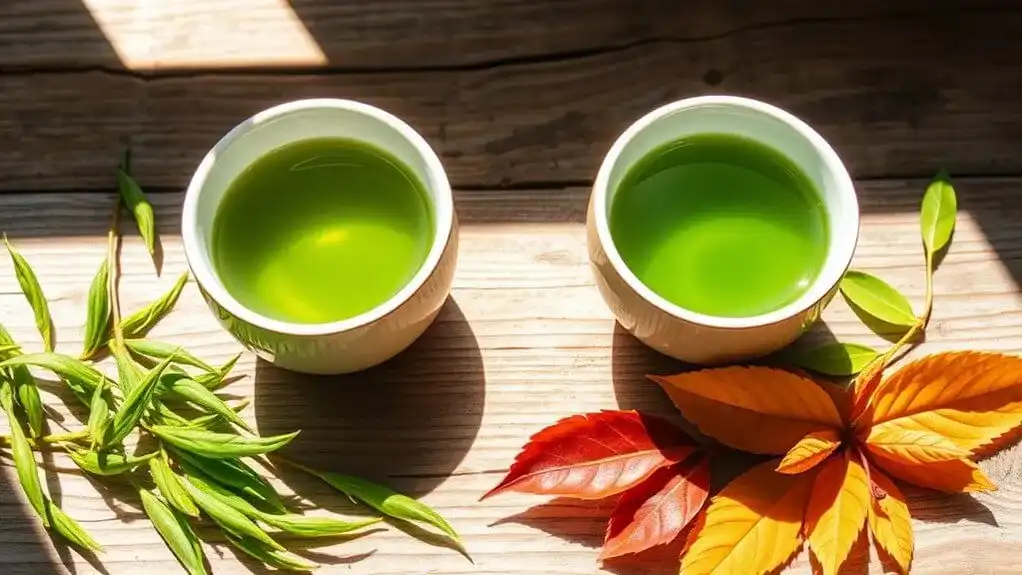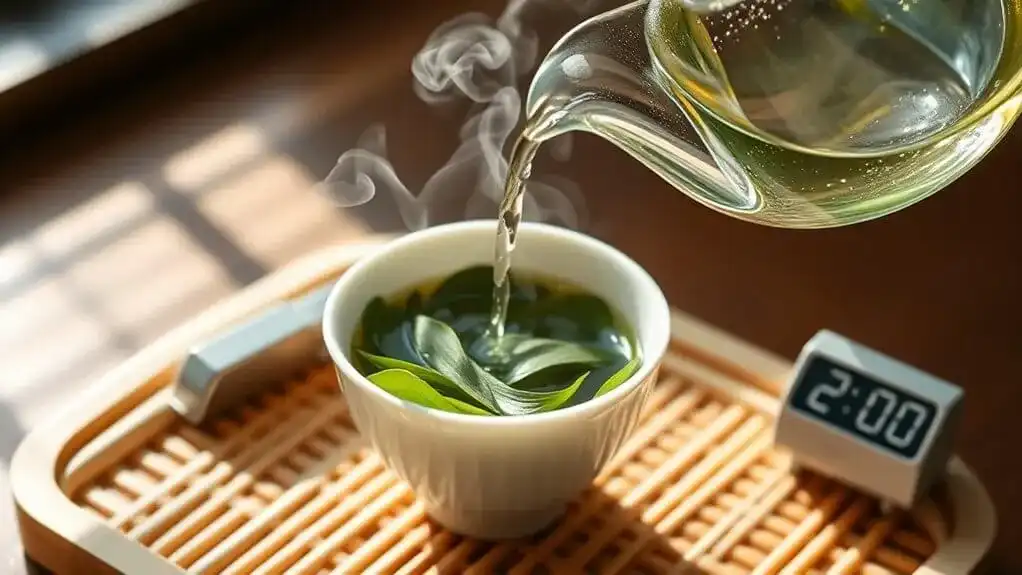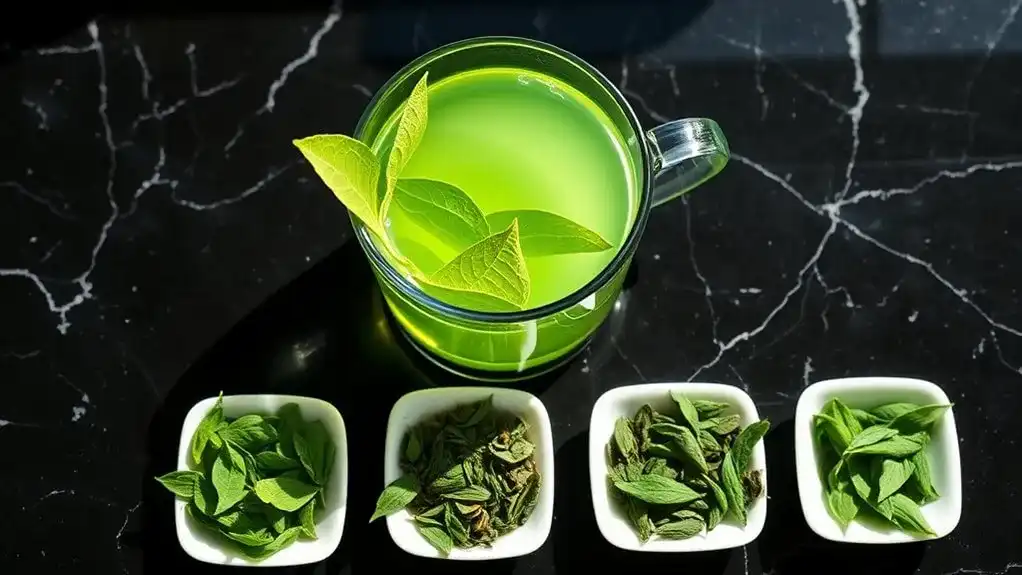Spring and autumn tea harvests create distinctly different flavor experiences. Spring teas offer delicate, sweet profiles with higher L-theanine content and can sustain multiple infusions due to concentrated nutrients. In contrast, autumn harvests produce more robust, complex flavors with increased aromatic oils but lower nutrient density. Environmental factors like temperature, sunlight, and soil conditions play essential roles in these seasonal variations. Understanding these differences reveals the full spectrum of green tea's fascinating complexity.
Key Points
- Spring harvests contain higher L-theanine levels, producing naturally sweeter flavors and a more delicate taste profile than autumn teas.
- Autumn teas develop increased tannins and aromatic oils due to rapid growth, resulting in more robust and complex flavors.
- Spring teas can sustain more infusions due to concentrated nutrients, while autumn teas typically offer fewer but distinctive steeps.
- Young spring leaves contain more trichomes contributing to sweetness, while autumn leaves are thinner with distinctive white hair.
- Spring harvests yield clear soups with floral notes, whereas autumn teas produce copper-green liquors with creamy characteristics.
The Science Behind Seasonal Tea Harvests
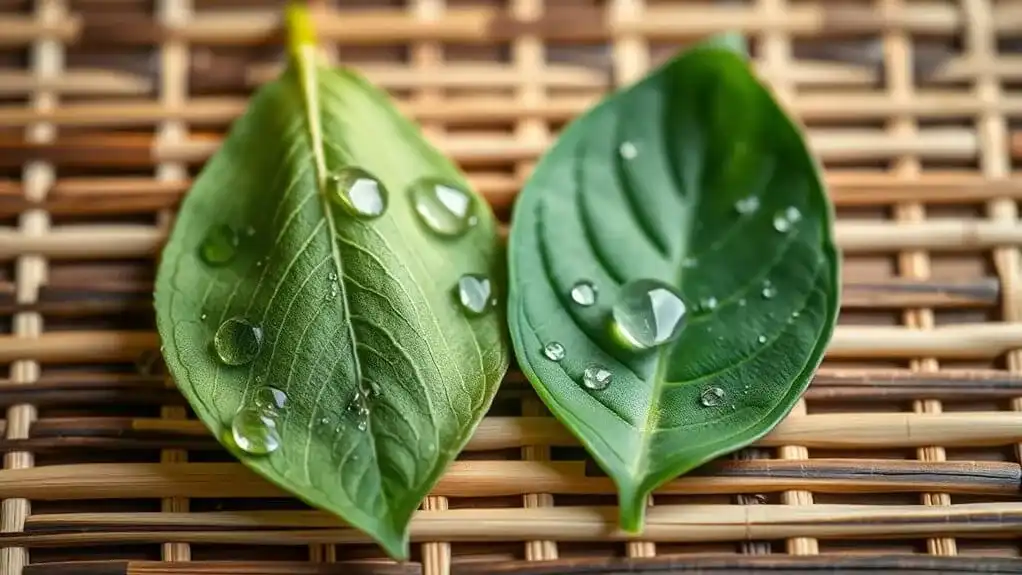
While many tea enthusiasts focus on brewing techniques, the science of seasonal harvests plays an essential role in determining green tea's flavor profile. The stark differences between spring and autumn harvests stem from varying growth conditions and nutrient density throughout the year. First harvests in mid-March yield the most sought-after teas of the season.
Spring harvests, occurring from late April to early May, produce leaves with higher L-theanine content due to slower winter growth. This results in sweeter, milder flavors and more complex taste profiles. In contrast, autumn's rapid growth cycle leads to increased tannin production, creating more bitter and astringent notes. During spring harvest, leaves contain up to three times the L-theanine. The harvest timing directly affects the chemical composition of tea leaves, with spring harvests yielding more concentrated nutrients. Spring harvest teas demonstrate superior quality by their ability to sustain eight plus infusions. This scientific relationship between growth rate and flavor compounds explains why spring harvests consistently produce superior green teas compared to their autumn counterparts.
Spring Tea's Delicate Profile Explained

Unlike autumn harvests, spring green teas showcase a remarkably delicate flavor profile due to their unique chemical composition. Higher amino acid levels paired with lower catechins create a naturally sweet taste with minimal bitterness. The presence of trichomes on young leaves contributes to spring tea's distinctive flavor nuances, adding both sweetness and a velvety texture. Spring teas produce remarkably clear soups when brewed properly. The tender leaves harvested in early spring contain optimal compounds thanks to cooler temperatures and gentle sunlight.
Spring tea's delicate aromas are characterized by floral notes and fresh vegetal undertones, often reminiscent of sweet corn and spinach. The nutrient-rich early spring harvest produces notably tart flavors that add complexity to the tea's profile. The tasting notes can vary based on processing methods and growing regions, with shaded varieties like Gyokuro offering rich umami flavors. Pectin content enhances the tea's body and sweetness, while proper brewing at 195°F brings out these subtle characteristics. First-flush harvests, particularly Shincha, deliver the most pronounced sweetness and complexity that tea connoisseurs prize.
Autumn's Robust Flavor Characteristics
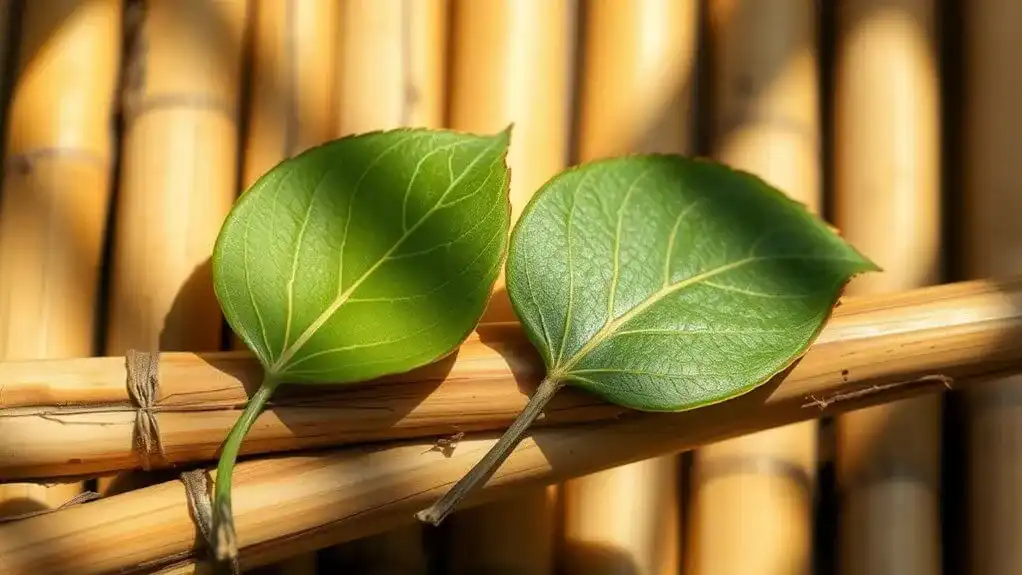
The robust character of autumn green tea stands in stark contrast to spring's delicate profile. While autumn tea leaves are thinner with distinctive white hair and yellower hues, they're rich in aromatic oils that create a unique flavor complexity. The clear, crisp autumn weather plays an essential role in developing and preserving these aromatic compounds during growth and processing. The autumn harvest typically produces tea leaves with lower catechin levels compared to spring harvests. Many tea enthusiasts appreciate these varieties for their caffeine-free options, making them perfect for evening consumption. As temperatures begin to cool, autumn tea develops complex flavor notes that distinguish it from other seasonal harvests.
Though autumn tea has a shorter growth period and accumulates fewer nutrients than spring varieties, it compensates with its remarkable fragrance profile. The brewed leaves display a copper-green color and yield a gentler taste that sits between spring and summer harvests. These characteristics make autumn tea particularly suitable for certain varieties, especially oolong and pu-erh, where the emphasis on fragrance over durability creates a distinctive seasonal expression.
Chemical Composition Through the Seasons
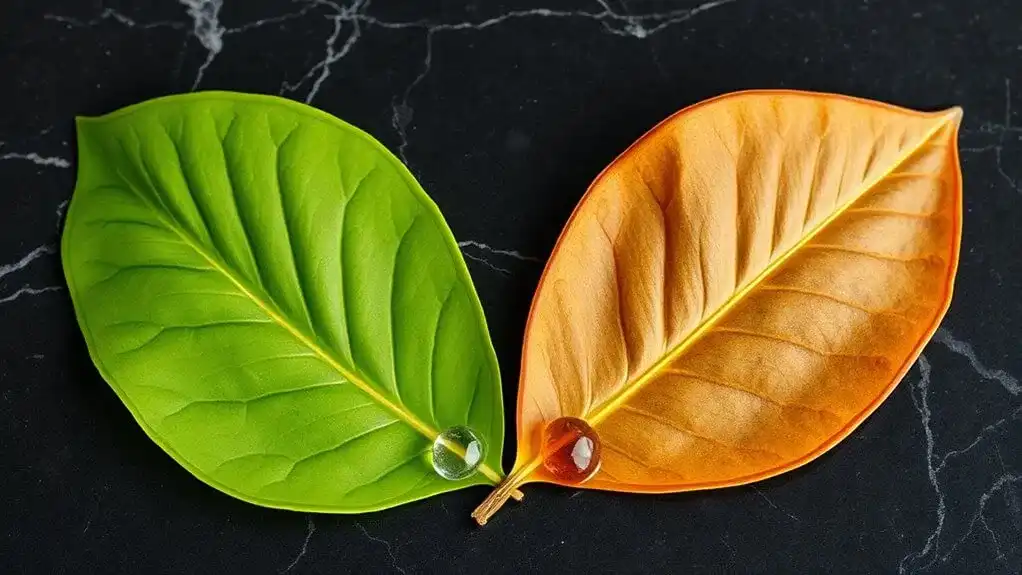
Seasonal changes drive significant variations in green tea's chemical composition, as evidenced by thorough analyses of phenolic profiles and volatile compounds. Spring harvests yield teas with sweet and floral notes, making them the most prized among consumers. The most notable chemical variations occur in total phenolics, ranging from 291-327 mg GAE/g, and flavonoids, varying between 50-70 mg RE/g across different seasons. Research shows that epigallocatechin-3-gallate content increased substantially from 2019 to 2020 harvests.
Each harvest period demonstrates distinct characteristics. Spring tea boasts higher theanine levels, producing a fresh, vibrant flavor. Summer harvests contain elevated theine and caffeine content due to intense sunlight exposure. Autumn tea develops more aromatic oils but shows lower nutrient accumulation. Good summer harvests achieve a hearty balance through controlled sunlight exposure. Seasonal antioxidants also fluctuate, with summer months displaying enhanced DPPH radical scavenging activity and FRAP values. The volatile compound profile expands from 68 compounds in spring to 82 in autumn, contributing to each season's unique flavor signature.
Climate's Impact on Tea Production
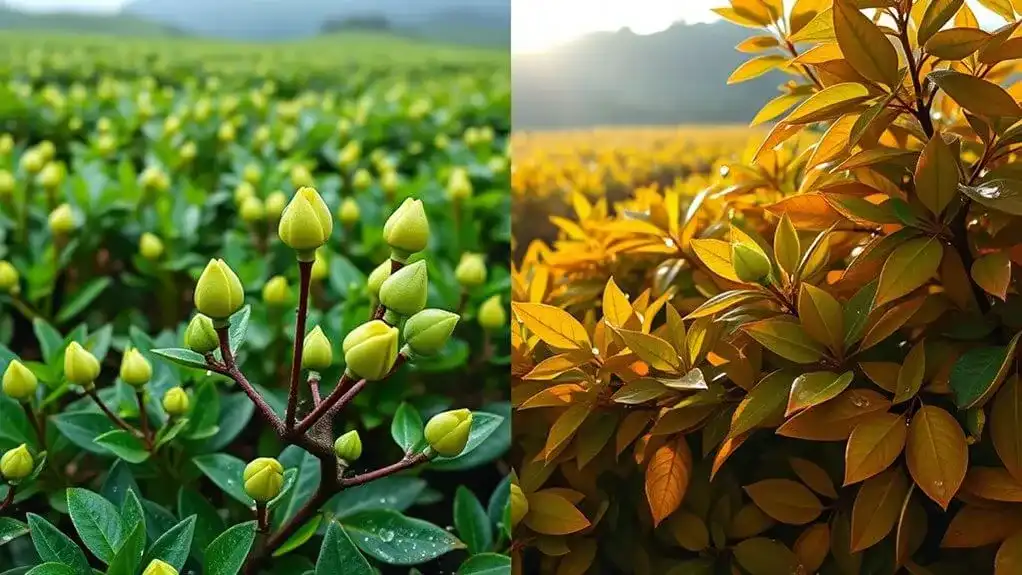
Modern climate change poses unprecedented challenges to global tea production, disrupting traditional growing patterns and threatening crop sustainability. Rising temperatures above 30°C greatly reduce yields, with every degree increase above 28°C resulting in a 4% loss. These climate variability effects extend beyond mere production numbers, impacting tea quality and flavor profiles.
China's largest freshwater lake reached record lows last summer amid severe drought conditions. Drought conditions have hit major tea-growing regions hard, with Indian and Kenyan estates experiencing yield reductions of up to 20%. The shift has been particularly devastating for early spring harvests, which historically produced the sweetest and most prized teas due to slow growth patterns. Meanwhile, pest population dynamics have intensified due to warmer temperatures, leading to increased crop damage. Extreme weather events, particularly hail and frost, cause lasting damage to tea bushes and can suspend harvesting for months. While adaptation strategies like enhanced cold tolerance and improved shade management offer some hope, the tea industry faces mounting pressure to evolve its cultivation practices.
Market Value and Consumer Preferences
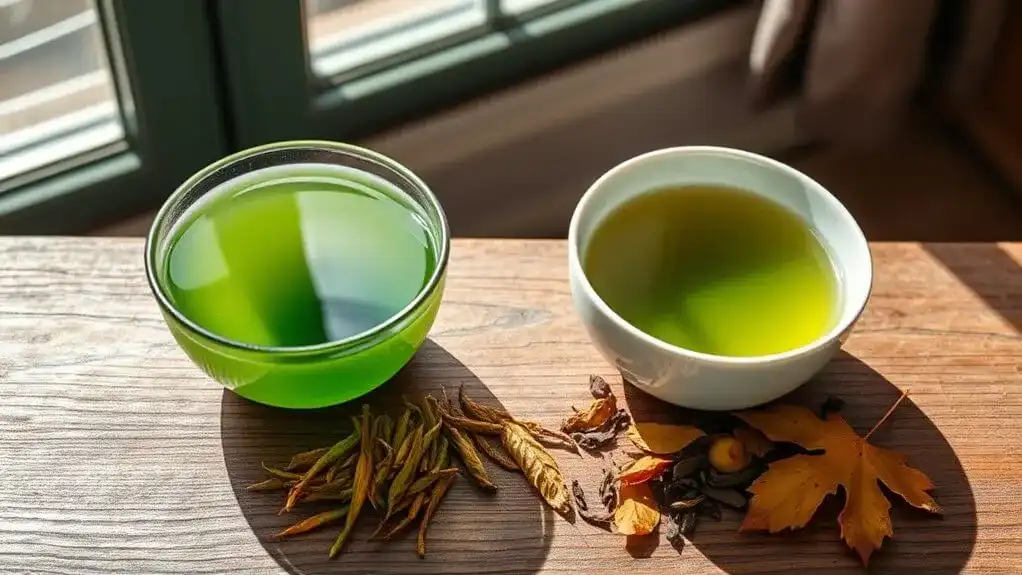
While climate challenges reshape tea production, market dynamics paint an optimistic picture for green tea's future. The global market, valued at $17.50 billion in 2023, is projected to reach $29.39 billion by 2030, driven by evolving consumer trends and health awareness. Research shows that consumers demonstrate higher trust levels in eco-friendly certified products, influencing purchasing decisions.
Consumer preferences have shifted dramatically toward wellness-focused beverages, with green tea emerging as a frontrunner in the functional drink category. Market dynamics reflect this shift, particularly in the Asia Pacific region, where cultural significance and high production levels dominate the industry. Green tea bags maintain product dominance in the market due to their convenience and accessibility. Today's consumers aren't just seeking traditional green tea; they're demanding innovative flavored variants and organic options. Companies like Bigelow Tea and Tata Consumer Products are responding with health-focused blends to meet this demand. E-commerce platforms have amplified this growth, making premium green tea products more accessible to health-conscious consumers worldwide, while rising disposable incomes support the market's expansion into premium segments.
Processing Methods Across Seasons

Processing methods for green tea vary greatly between spring and autumn harvests, with each season demanding distinct approaches to preserve ideal flavor profiles. Spring harvests require immediate heat treatment within 24 hours to prevent oxidation and maintain chlorophyll content, while autumn processing techniques can be more gradual due to the tea plant's slower growth phase. The fixation stage prevents enzymatic oxidation and is especially critical during spring harvests.
The core difference lies in oxidation management and timing. Spring teas need quick processing to capture their delicate, floral notes, whereas autumn teas benefit from a longer window that allows their complex, creamy flavors to develop. Harvesters traditionally use soft bamboo baskets to transport the leaves from field to processing facility to prevent bruising and maintain quality. The final step involves pre-firing and sorting to enhance preservation and create a balanced flavor profile. While both seasons use similar rolling and shaping methods, the heat application varies considerably. Japanese-style processing relies on steaming for vegetal notes, while Chinese methods employ pan-frying for nuttier flavors, regardless of season.
The Role of Terroir in Seasonal Flavors
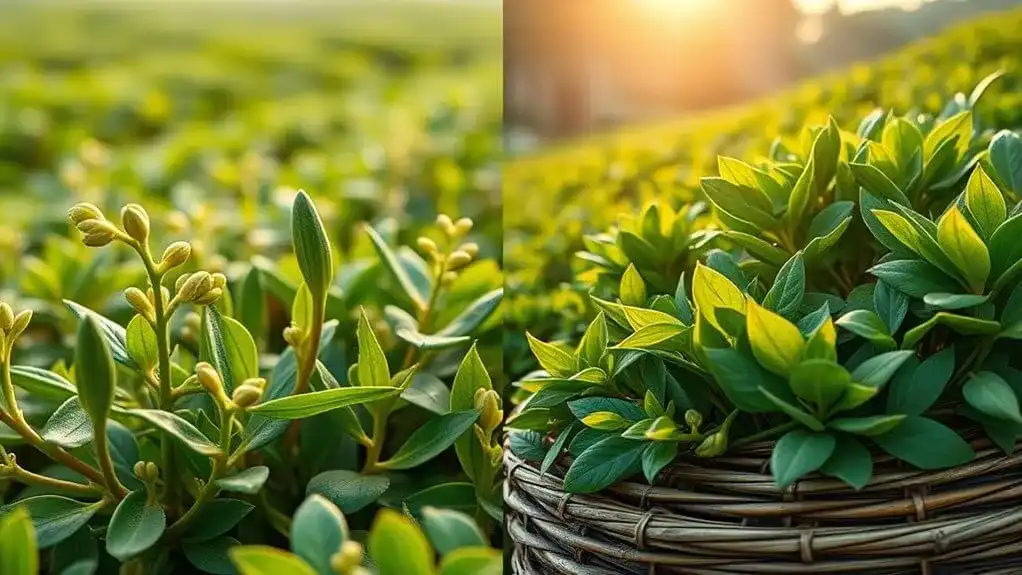
Throughout the tea-growing calendar, terroir plays a defining role in shaping the distinct flavors of seasonal green tea harvests. The terroir influence extends beyond mere location, encompassing soil composition, climate, and topographical elements that create unique flavor variations between spring and autumn harvests. During spring harvests, tea leaves contain higher sugar content due to energy stored during winter dormancy.
Soil characteristics, particularly in volcanic regions, contribute mineral-rich nutrients that affect the tea's taste profile differently across seasons. Higher altitude gardens typically produce slower-growing leaves with more concentrated flavors, while lower elevations yield faster-growing varieties with different characteristics. Weather patterns, including temperature fluctuations and rainfall, considerably impact each season's harvest quality. The local ecosystem's microorganisms and organic matter in the soil further enhance these seasonal differences, creating distinct flavor profiles that reflect the natural conditions of each growing period. Major green tea regions like Boseong and Hadong in Korea exemplify how terroir creates distinctive regional characteristics in seasonal harvests. Traditional production methods passed down through generations help maintain the authenticity of each region's seasonal tea characteristics.
Conclusion
Like nature's own theater, spring and autumn teas dance on opposite ends of the flavor spectrum. Spring's delicate whispers and autumn's bold declarations aren't just coincidence – they're the result of an intricate ballet between sunlight, soil, and season. While both harvests offer distinct pleasures, understanding these seasonal nuances helps tea lovers choose the perfect cup to match their mood and palate.
